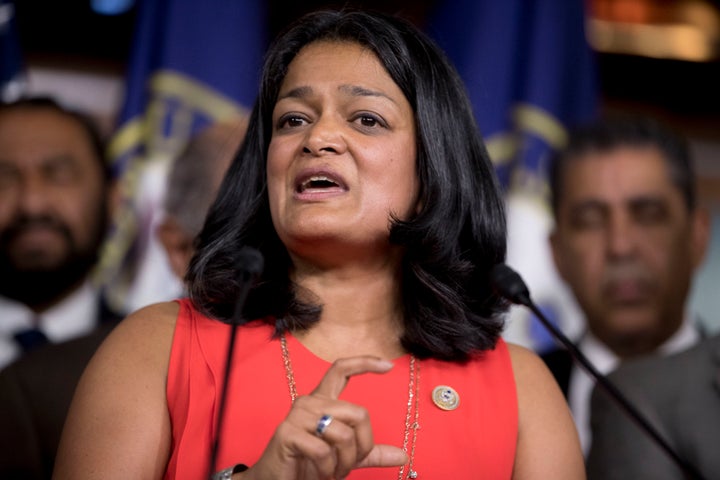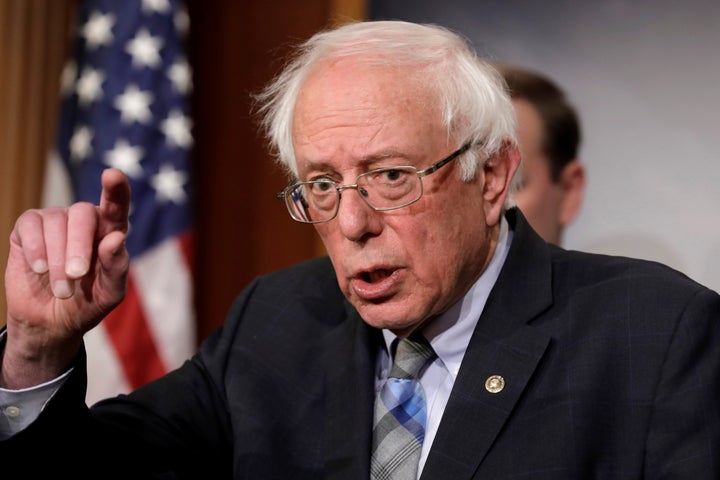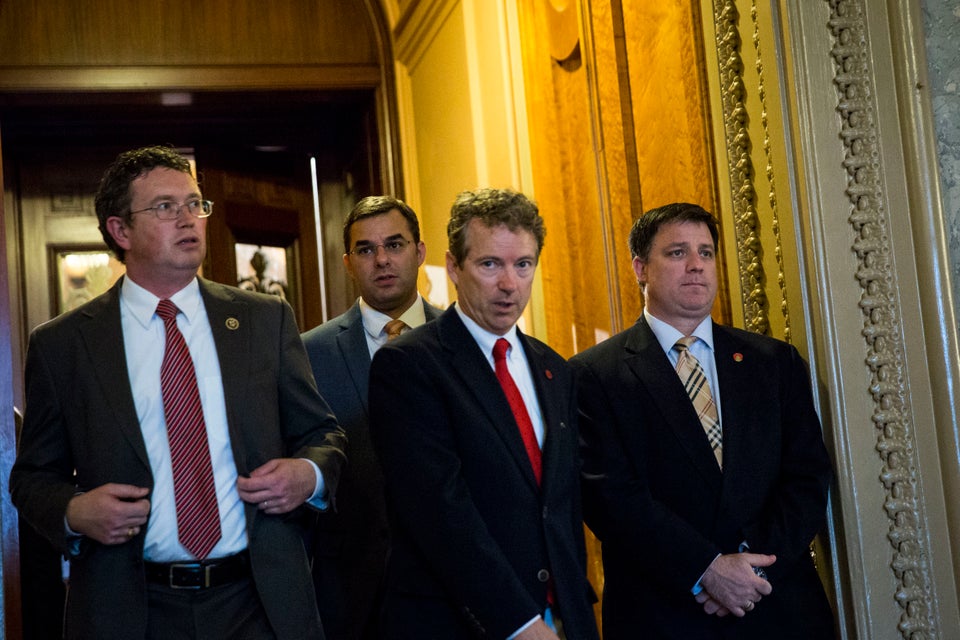Rep. Pramila Jayapal (D-Wash.) is unveiling legislation Wednesday that would create a single-payer health insurance program to cover every person in the country.
The legislation, the Medicare for All Act of 2019, is a souped-up version of bills that garnered majority support from the House Democratic Caucus and one-third of the Senate Democratic Caucus in the last Congress.
Even though Democrats hold 40 more seats in the House and majority control, the new “Medicare for all” bill has 18 fewer sponsors than its legislative predecessor, H.R. 676, did in the previous Congress.
Over two dozen incumbent Democrats who signed on to H.R. 676 have declined to do so this time around. Their backtracking raises the prospect that the closer single-payer comes to reality, the more squeamish it makes some Democrats.
“Let’s stop nibbling around the edges. This is a crisis of enormous magnitude. And our response has to be proportional to that crisis,” Jayapal said in a call with reporters on Tuesday afternoon. “People are dying. They can’t afford their drugs.”
“There are some things that should not be provided through the for-profit marketplace, and we believe health care is one,” she added.
Asked about the drop-off in support from H.R. 676 ― the latest version of which then-Rep. John Conyers (D-Mich.) introduced in January 2017 ― Jayapal observed that Conyers began with fewer than half as many co-sponsors as her bill now has.
She also noted the extent of support among freshman Democrats who flipped Republican seats in difficult races. At least 16 first-year Democrats have signed on to the bill — including Reps. Katie Hill (Calif.), Katie Porter (Calif.), Josh Harder (Calif.), Susan Wild (Pa.) and Jared Golden (Maine), who won previously GOP-held seats.

“Medicare for all” has advanced leaps and bounds from just four years ago, when it was widely dismissed in the halls of Congress as a left-wing pipe dream.
But the 2016 presidential run of Sen. Bernie Sanders (I-Vt.) demonstrated the idea’s untapped popularity for lawmakers, launching it squarely into the Democratic mainstream. It quickly became a sort of litmus test for the party’s would-be progressive standard bearers.
For the first time in decades, single-payer legislation will be the subject of serious hearings in two House committees — albeit in the rules and budget panels, not in one with direct jurisdiction such as the commerce committee.
The hearings aim to “get a real discussion on this going,” Jayapal said. “We will get to hear exactly what the plan involves and what the costs are to the current system that we have.”
Under the new House bill, an expanded Medicare program would replace private health insurance, Medicaid and all other forms of health coverage except existing programs for military veterans and Native Americans. Private plans would be permitted only to cover services, such as cosmetic procedures, not covered by Medicare. Jayapal’s office provided a summary of the bill to reporters Tuesday.
The measure would also radically overhaul how hospitals and other medical providers are paid and include strong provisions to reduce prescription drug prices. The legislation does not include a financing mechanism, but Jayapal aides told reporters that various tax increases on wealthy people and businesses are on the table and that employers might pay into the system rather than provide health benefits to workers. Lower payments to medical providers and less spending on administration are intended to reduce overall costs.
The Jayapal bill goes further than other “Medicare for all” plans, including older proposals from Sanders and others. Notably, the legislation would provide coverage for long-term care services, including nursing-home stays, that currently aren’t covered under Medicare. Compared with other Democratic plans to create a public option that would compete with private insurers or allow people to buy into the current Medicare or Medicaid programs, the Jayapal legislation is far more sweeping.

The advantages of a full transition to “Medicare for all” are simple to describe. Every U.S. resident would have the same generous medical, dental and mental health benefits and pay nothing when they receive services. Instead, tax dollars would finance medical services and products. The federal government would take over for private health insurance companies, but medical providers such as physicians and hospitals would remain private. The Jayapal bill would implement this new system over two years ― twice as fast as the legislation Sanders introduced in September 2017.
Health insurance would not be eliminated, but insurers would not be permitted to sell policies to duplicate what “Medicare for all” would cover. Instead, insurance companies could offer supplemental coverage for services not included in the single-payer program. Likewise, while medical providers would remain private, any doctor or other provider participating in the government program would be forbidden to accept payments from patients who don’t want to use the federal program. Medical providers who opt out of “Medicare for all,” however, could enter into private contracts with patients.
Hospitals and other institutional health care providers would see a major change in how they’re paid. Today, medical providers typically are paid on a fee-for-service basis. The Jayapal bill would eliminate that practice and pay health care facilities a flat annual rate. Physicians would continue to be paid through a fee-for-service system at rates set by the federal government. The summary of the Jayapal bill did not include details about how payments to medical providers would be calculated.
The bill would tackle drug pricing in two main ways. First, the federal government would negotiate prices with pharmaceutical companies, much as health care systems in other countries do. Second, the bill would allow the government to compel the sale of cheaper generic versions of medicines if brand-name manufacturers don’t agree to accept government-set prices for their products — another practice common in other nations’ health care systems
And the legislation would undo current restrictions on government funding for abortions and reproductive health services, including the Hyde Amendment.
The unanswered questions about how much the government would pay for medical care and how the program would be financed are significant. High prices for medical treatment and products are the primary reason health care is so expensive in the United States. And while much of the spending on a “Medicare for all” program would simply be redirected from how that money is spent today, the Jayapal bill would not only cover more people but also offer a more generous benefit package than most Americans currently have.
The heavy political lift of making this bill (or other single-payer proposals) law should not be underestimated, despite the invigorated popularity of this approach on the left.
“People are not saying that they’re dying to have health insurance companies in their lives.”
- Rep. Pramila Jayapal (D-Wash.)
The health care industry already is marshaling resistance to “Medicare for all” and to even more modest plans to increase the federal government’s role in providing health coverage. It’s no mystery why. In addition to all but eradicating the health insurance industry, “Medicare for all” would have to drastically cut payments to medical providers in order to reduce costs and bring the U.S. in line with other nations’ per capita spending.
And the potential for a backlash among Americans who already have health coverage is real. Eliminating private health insurance for major medical coverage would mean that hundreds of millions of Americans would have to give up what they currently have. Whatever the merits of “Medicare for all” versus private insurance, fear of disruption alone could be enough to sour swaths of voters on the idea. Many were angry when the Affordable Care Act forced a few million people to change their health insurance in 2014, and a transition to “Medicare for all” would affect nearly everyone in America.
Jayapal maintained that public worries over losing their private coverage were rooted in insurance industry misinformation claiming a single-payer plan would limit people’s choice of doctors and hospitals.
“People are not saying that they’re dying to have health insurance companies in their lives,” she said.
But the worries, however misguided, remain an obstacle. A January poll conducted by the Henry J. Kaiser Family Foundation showed that support for “Medicare for all” drops precipitously when respondents learn that it would eliminate private health insurance companies.
On top of these challenges, Republicans control the Senate, and Donald Trump is president.
The smaller number of co-sponsors on the Jayapal bill also highlights the lack of consensus among Democrats on how to move forward on health policy.
The House Democratic leadership, including the chairmen of the powerful committees that would be charged with advancing this bill, has been noncommittal at best. And a growing number of more centrist Democrats are promoting less drastic policies, like the public option, that may appeal to lawmakers and presidential candidates nervous about backing an overhaul of the entire health care system.
The legislation enjoys major support from progressive organizations and labor unions, including the influential Service Employees International Union, the National Education Association, the American Federation of Teachers and the International Association of Machinists. Although the AFL-CIO federation of unions supports “Medicare for all,” many individual unions have been reluctant to fight for “Medicare for all” efforts in recent decades. Those organizations are wary, in some cases, of jeopardizing employer-sponsored coverage they have spent years negotiating for.
Jennifer Epps-Addison, the president of the Center for Popular Democracy Action, which organizes low-income communities of color and is backing the legislation, said that even though she and her husband had decent employer-sponsored coverage, his multiple sclerosis diagnosis three years ago turned their world “upside down.” They struggle to afford their out-of-pocket health care costs, she said, particularly now that her husband is out of work.
“It’s clear that this system is not only not working for low-income families but it is not working for middle-class families like mine,” she said.
